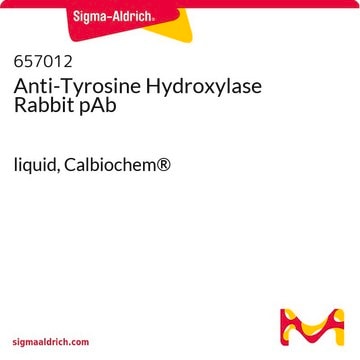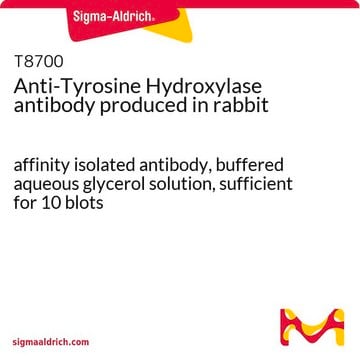MAB318
Anti-Tyrosine Hydroxylase Antibody, clone LNC1
ascites fluid, clone LNC1, Chemicon®
Synonim(y):
TH, Tyrosine Monooxygenase, Tyrosine 3-monooxygenase
About This Item
Polecane produkty
pochodzenie biologiczne
mouse
Poziom jakości
forma przeciwciała
ascites fluid
rodzaj przeciwciała
primary antibodies
klon
LNC1, monoclonal
reaktywność gatunkowa
zebrafish, mouse, rat, vole, human, frog, lizard, monkey, chicken
producent / nazwa handlowa
Chemicon®
metody
immunohistochemistry (formalin-fixed, paraffin-embedded sections): suitable
immunoprecipitation (IP): suitable
western blot: suitable
izotyp
IgG1κ
numer dostępu NCBI
numer dostępu UniProt
Warunki transportu
dry ice
docelowa modyfikacja potranslacyjna
unmodified
Opis ogólny
Specyficzność
Immunogen
Zastosowanie
A 1:200-1:400 dilution of a previous lot was used in IH. 4% PFA fixed, frozen sections; 4% PFA fixed, paraffin sections 1:100 (Barrachina, M. et al., 2003). For paraffin sections Barrachina reported successful staining with microwave citrate acid antigen recovery, however other methods can likely be used as well.
Immunoprecipitation:
A previous lot of this antibody was used in IP (Perez, 2002).
Optimal working dilutions and protocols must be determined by end user.
Neuroscience
Neurotransmitters & Receptors
Neuronal & Glial Markers
Jakość
Western blot:
1:1000 dilution of this lot detected Tyrosine Hydroxylase on 10 μg of Mouse Brain lysates.
Opis wartości docelowych
Postać fizyczna
Przechowywanie i stabilność
Komentarz do analizy
Human brain tissue, extracts from 3T3 cells treated with Forskolin (40 nM, 30 min).
Informacje prawne
Oświadczenie o zrzeczeniu się odpowiedzialności
Not finding the right product?
Try our Narzędzie selektora produktów.
polecane
Kod klasy składowania
12 - Non Combustible Liquids
Klasa zagrożenia wodnego (WGK)
WGK 2
Temperatura zapłonu (°F)
Not applicable
Temperatura zapłonu (°C)
Not applicable
Certyfikaty analizy (CoA)
Poszukaj Certyfikaty analizy (CoA), wpisując numer partii/serii produktów. Numery serii i partii można znaleźć na etykiecie produktu po słowach „seria” lub „partia”.
Masz już ten produkt?
Dokumenty związane z niedawno zakupionymi produktami zostały zamieszczone w Bibliotece dokumentów.
Klienci oglądali również te produkty
Produkty
Explore the basics of working with antibodies including technical information on structure, classes, and normal immunoglobulin ranges.
Antibodies combine with specific antigens to generate an exclusive antibody-antigen complex. Learn about the nature of this bond and its use as a molecular tag for research.
Learn differences in monoclonal vs polyclonal antibodies including how antibodies are generated, clone numbers, and antibody formats.
Poznaj różnice między przeciwciałami monoklonalnymi i poliklonalnymi, w tym sposób generowania przeciwciał, numery klonów i formaty przeciwciał.
Protokoły
Tips and troubleshooting for FFPE and frozen tissue immunohistochemistry (IHC) protocols using both brightfield analysis of chromogenic detection and fluorescent microscopy.
Nasz zespół naukowców ma doświadczenie we wszystkich obszarach badań, w tym w naukach przyrodniczych, materiałoznawstwie, syntezie chemicznej, chromatografii, analityce i wielu innych dziedzinach.
Skontaktuj się z zespołem ds. pomocy technicznej

















